cruise control OLDSMOBILE SILHOUETTE 1998 Owners Manual
[x] Cancel search | Manufacturer: OLDSMOBILE, Model Year: 1998, Model line: SILHOUETTE, Model: OLDSMOBILE SILHOUETTE 1998Pages: 444, PDF Size: 23.2 MB
Page 154 of 444
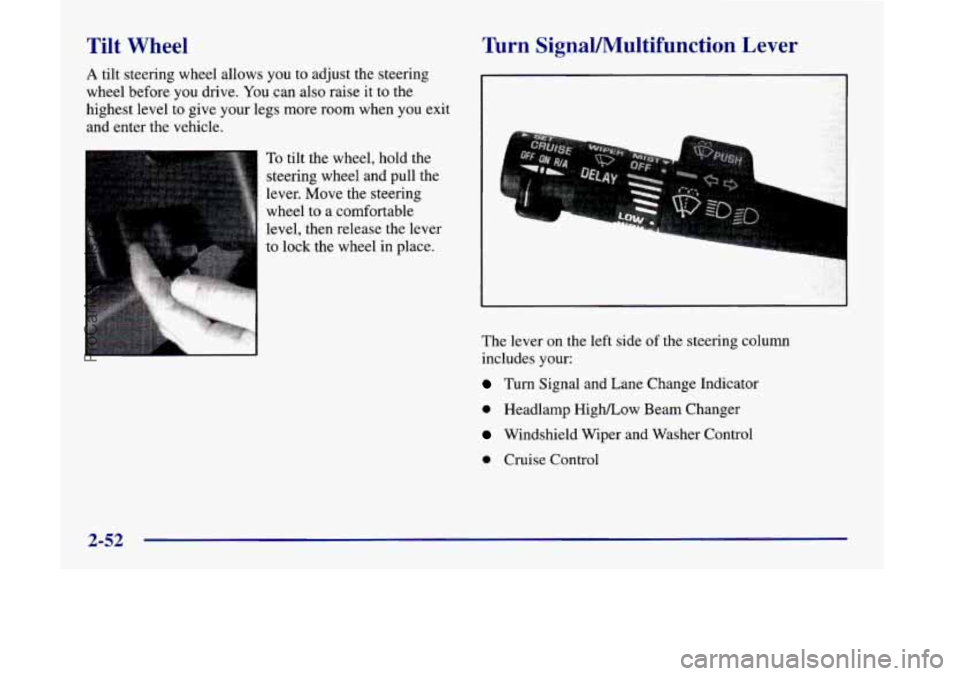
Tilt Wheel
A tilt steering wheel allows you to adjust the steering
wheel before
you drive. You can also raise it to the
highest level to give your legs more room when you exit
and enter the vehicle.
To tilt the wheel, hold the
steering wheel and pull the
lever. Move the steering
wheel to a comfortable
Turn SignaVMultifunction Lever
1
Icr
I
The lever on the left side of the steering column
includes your:
Turn Signal and Lane Change Indicator
0 Headlamp HighLow Beam Changer
Windshield Wiper and Washer Control
0 Cruise Control
2-52
ProCarManuals.com
Page 157 of 444
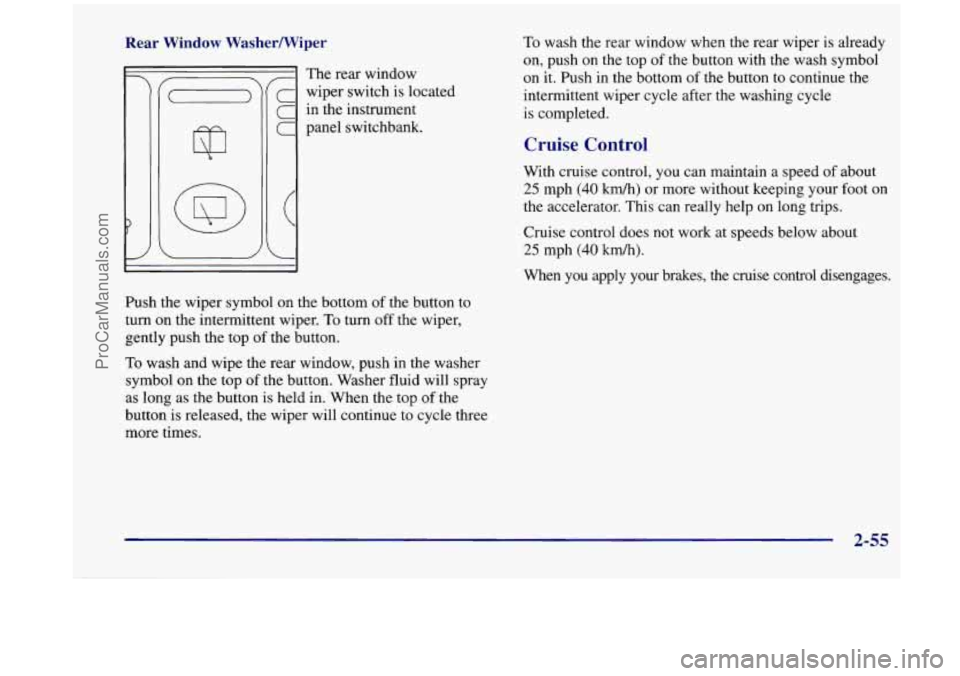
Rear Window Washermiper
7
C
C
C
(
L
The rear window
wiper switch is located
in the instrument
panel switchbank.
I
Push the wiper symbol on the bottom of the button to
turn on the intermittent wiper. To turn
off the wiper,
gently push the top
of the button.
To wash and wipe the rear window, push in the washer
symbol on the top of the button. Washer fluid will spray
as long as the button is held in. When the top of the
button is released, the wiper will continue to cycle three
more times. To
wash the rear window when the rear wiper
is already
on, push on the top
of the button with the wash symbol
on it. Push in the bottom
of the button to continue the
intermittent wiper cycle after the washing cycle
is completed.
Cruise Control
With cruise control, you can maintain a speed of about
25 mph (40 kdh) or more without keeping your foot on
the accelerator. This can really help on long trips.
Cruise control does not work at speeds below about
25 mph (40 km/h).
When you apply your brakes, the cruise control disengages.
2-55
ProCarManuals.com
Page 158 of 444
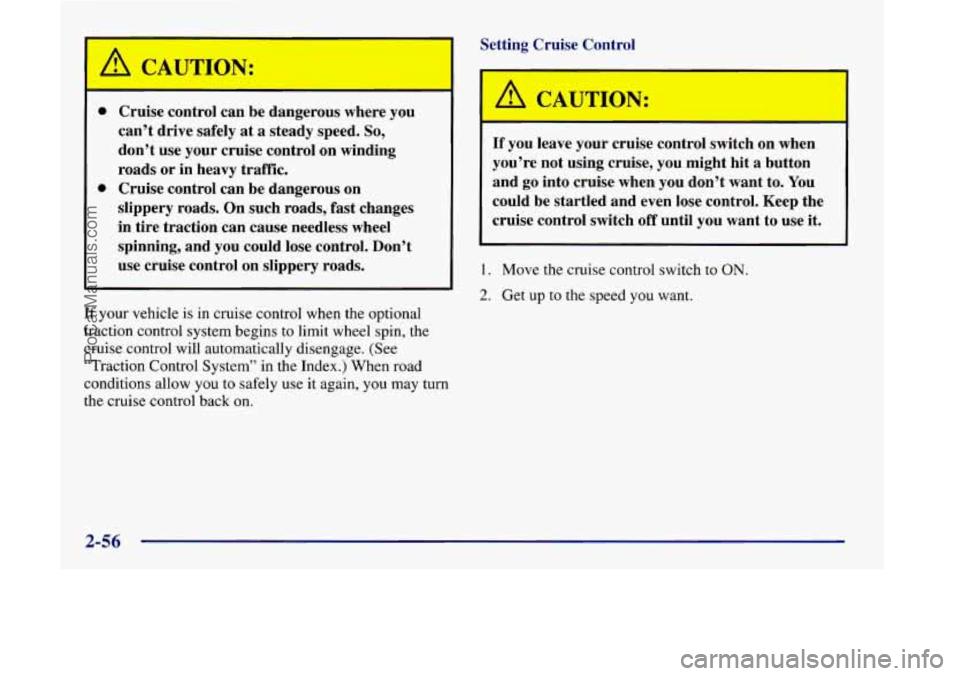
A CAUTION:
0
0
Cruise control can be dangerous where you
can’t drive safely at
a steady speed. So,
don’t use your cruise control on winding
roads or in heavy traffic.
Cruise control can be dangerous on
slippery roads. On such roads, fast changes
in tire traction can cause needless wheel
spinning, and you could lose control. Don’t
use cruise control on slippery roads.
If your vehicle
is in cruise control when the optional
traction control system begins
to limit wheel spin, the
cruise control will automatically disengage. (See
“Traction Control System” in the Index.) When road
conditions allow you to safely use
it again, you may turn
the cruise control back on. Setting Cruise Control
- CAUTION:
If you
leave your crulse control switch on when
you’re not using cruise, you might hit a button
and go into cruise when you don’t want to. You
could be startled and even lose control. Keep the
cruise control switch off until you want to use
it.
1. Move the cruise control switch to ON.
2. Get up to the speed you want.
2-56
ProCarManuals.com
Page 159 of 444
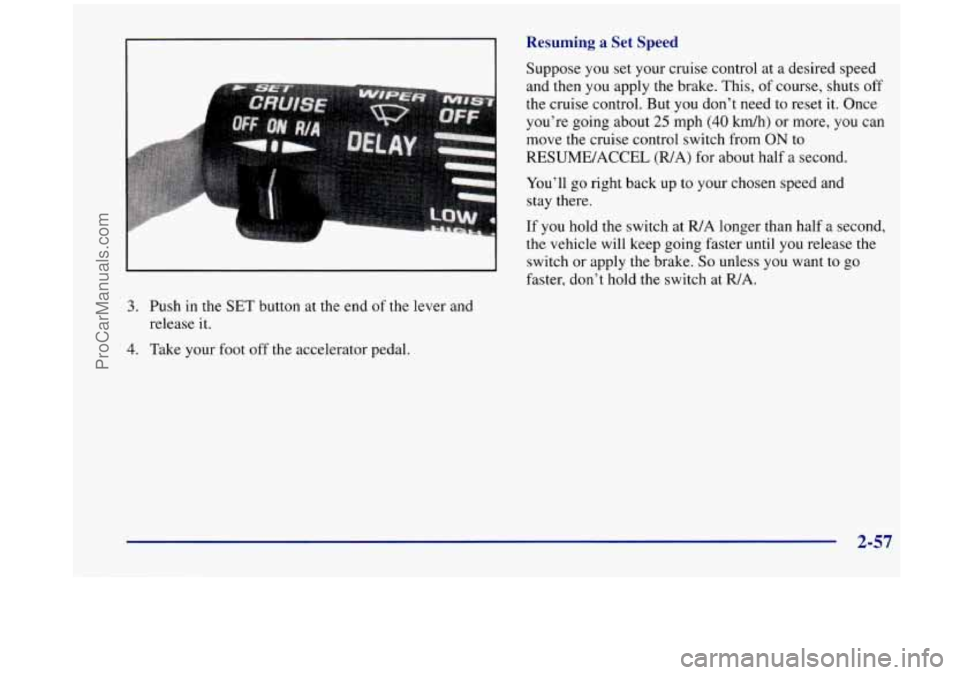
3. Push in the SET button at the end of the lever and
release it
.
4. Take your foot off the accelerator pedal.
Resuming a Set Speed
Suppose you set your cruise control at a desired speed
and then you apply the brake. This, of course, shuts off
the cruise control. But you don’t need to reset it. Once
you’re going about
25 mph (40 km/h) or more, you can
move the cruise control switch from
ON to
RESUME/ACCEL
@/A) for about half a second.
You’ll go right back up to your chosen speed and
stay there.
If you hold the switch at
R/A longer than half a second,
the vehicle will keep going faster until
you release the
switch or apply the brake.
So unless you want to go
faster, don’t hold the switch at WA.
2-57
ProCarManuals.com
Page 160 of 444
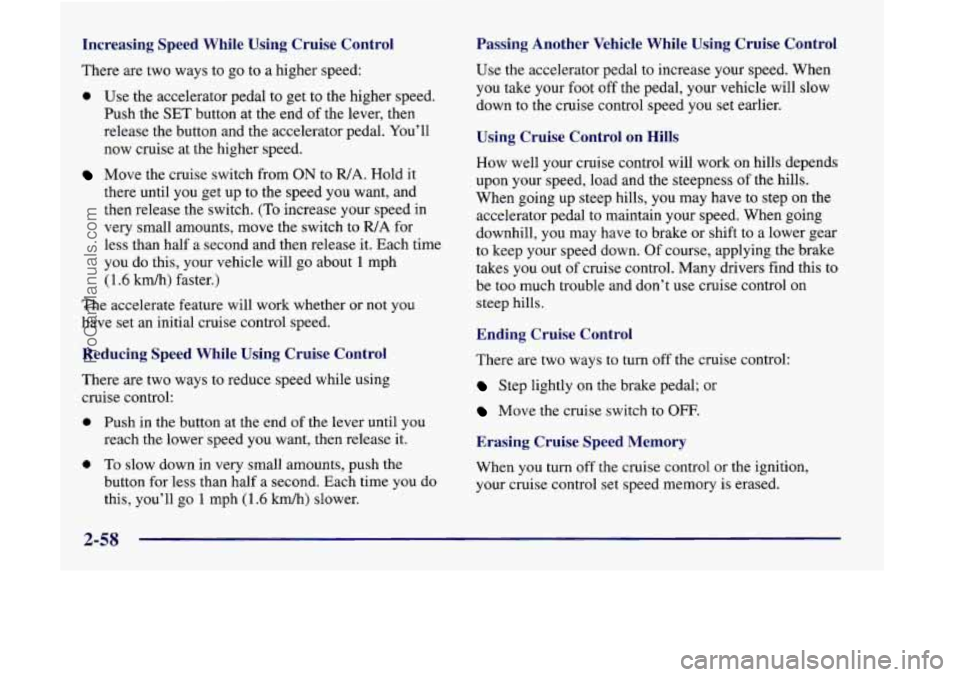
Increasing Speed While Using Cruise Control
There are two ways to go to a higher speed:
0 Use the accelerator pedal to get to the higher speed.
Push the
SET button at the end of the lever, then
release the button and the accelerator pedal. You’ll
now cruise at the higher speed.
Move the cruise switch from ON to WA. Hold it
there until you get up to the speed you want, and
then release the switch.
(To increase your speed in
very small amounts, move the switch
to WA for
less than half a second and then release it. Each time
you do this, your vehicle will go about
1 mph
(1.6 krn/h) faster.)
The accelerate feature will work whether or not you
have set an initial cruise control speed.
Reducing Speed While Using Cruise Control
There are two ways to reduce speed while using
cruise control:
0 Push in the button at the end of the lever until you
reach the lower speed you want, then release
it.
0 To slow down in very small amounts, push the
button for less than half a second. Each time you do
this, you’ll go
1 mph (1.6 km/h) slower.
Passing Another Vehicle While Using Cruise Control
Use the accelerator pedal to increase your speed. When
you take your foot off the pedal, your vehicle will slow
down to the cruise control speed you set earlier.
Using Cruise Control on Hills
How well your cruise control will work on hills depends
upon your speed, load and the steepness of the hills.
When going up steep hills, you may have to step on the
accelerator pedal to maintain your speed. When going
downhill, you may have to brake or shift to a lower gear
to keep your speed down. Of course, applying the brake
takes you out of cruise control. Many drivers find this to
be too much trouble and don’t use cruise control on
steep hills.
Ending Cruise Control
There are two ways to turn off the cruise control:
Step lightly on the brake pedal; or
Move the cruise switch to OFF.
Erasing Cruise Speed Memory
When you turn off the cruise control or the ignition,
your cruise control set speed memory is erased.
2-58
ProCarManuals.com
Page 241 of 444

Remember: Anti-lock doesn’t change the time you need
to get your foot up to the brake pedal or always decrease
stopping distance. If you get too close to the vehicle in
front of you, you won’t have time to apply your brakes
if that vehicle suddenly slows or stops. Always leave
enough room up ahead to stop, even though you have
anti-lock brakes.
Using Anti-Lock
Don’t pump the brakes. Just hold the brake pedal down
firmly and
let anti-lock work for you. You may feel a
slight brake pedal pulsation or notice some noise, but
this is normal.
If your vehicle has the
traction control system, this
LOW light will come on when
your anti-lock system is
help avoid a braking
skid.
TRACTI adjusting brake pressure to
See “Low Traction Light” in the Index.
Traction Control System (If Equipped)
Your vehicle may have a traction control system that
limits wheel spin. This is especially useful
in slippery
road conditions. The system operates only if it senses
that
one or both of the front wheels are spinning or
beginning to lose traction. When this happens, the
system works the front brakes and reduces engine power
to limit wheel spin.
This light will come on
when the traction control
system is limiting wheel
spin. See “Low Traction
Light” in the Index.
LOW
TRACTION
You may feel or hear the system working, but this
is normal.
If your vehicle is in cruise control when the traction
control system begins to limit wheel spin, the cruise
control will automatically disengage. When road
conditions allow you to safely
use it again, you may
reengage the cruise control. (See “Cruise Control”
in the Index.)
ProCarManuals.com
Page 368 of 444

r
FUSE USAGE CHART
CIRCUIT LH T/LP RH T/LP
SWC
BACKLIGHT
3REAKERS
I HEADLAMP ELEC PRNDL
ABS SOL ELC RR DEFOG RR FOG LP
PWR MIRROR CTSY
LAMP FRT PWR
SCKT
CIGARDLC
Fl FRT HVAC/HI
1 CRUISE I TiSlG I SIR
I PWROTRVENT I RRHVAC I FR&~~$~~~w' I SUNROOF I HVAC/DRL I
FRT WPRMSHR BCM
PRGRM
RR WPA WSHR
MALURADIO/DIC
SWC ACCY
LH HEADLP RH
HEADLP
HAZARD LOW LOW
I PWR LOCK I RR PWR SCKT 1 ABS MOD BATr I LH:ktDLP I RH%DLp
I I DRL I CANVENTSOL I ABSFCS IGN I PCM /
For More information, See Owner's Manual Printed in /
Circuit Breakers
HEADLAMP
PWR WDOIRR
VENT
PWR SEATIPSD
FRT HVAC/HI
BLWR DRL
Control Module,
Headlamp and
I/P
Dimmer Switch
Front Power Windows
6-Way Power Seat(s) and Rear
Side Door Actuator Motor
Blower Motor Hi Speed Relay
in Module
Fuses
swc
BACKLIGHT
ELEC PRNDL
PWR MIRROR Steering Wheel
Radio Control
Switches (Illumination)
Instrument Cluster to
PRNDL Indicators
Power Remote Control
Mirror Switch
CRUISE Cruise Control Module, Switch
and Release Switch
PWR QTR VENT Interior Lamps and
Multifunction Switch
(Power Vent Switch)
FRT WPWSHR Windshield Wipermasher
Motor and Switch
BCM
PWR LOCK
RH TLP
RR FOG LP
CIGARIDLC
TISIG Not
Used
Not Used Cigarette Lighter and Data Link
Connector (DLC)
Turn Signal Switch
6-58
ProCarManuals.com
Page 409 of 444

Part C: Periodic Maintenance
Inspections
Listed below are inspections and services which should be
performed at least twice a year (for instance, each spring and fall).
You should let your retailerk service department
or other qualified service center do these jobs. Make sure
any necessary repairs are completed at once.
Proper procedures to perform these services may be
found in a service manual.
See “Service and Owner
Publications” in the Index.
Steering, Suspension and Front Drive Axle
Boot and Seal Inspection
Inspect the front and rear suspension and steering system
for damaged, loose or missing parts, signs of wear or lack
of lubrication. Inspect the power steering lines and hoses
for proper hook-up, binding, leaks, cracks, chafiig, etc.
Clean and then inspect the drive axle boot seals for
damage, tears or leakage. Replace seals if necessary.
Exhaust System Inspection
Inspect the complete exhaust system. Inspect the body near
the exhaust system. Look for broken, damaged, missing or
out-of-position parts as well as open seams, holes, loose
connections or other conditions which could cause a heat build-up
in the floor pan or could let exhaust fumes into
the vehicle. See “Engine Exhaust”
in the Index.
Engine Cooling System Inspection
Inspect the hoses and have them replaced if they are
cracked, swollen or deteriorated. Inspect all pipes, fittings
and clamps; replace as needed. Clean the outside of the
radiator and
air conditioning condenser. To help ensure
proper operation, a pressure test of the cooling system and
pressure cap
is recommended at least once a year.
Throttle System Inspection
Inspect the throttle system for interference or binding, and for
damaged or missing parts. Replace parts as needed. Replace
any components that have high effort or excessive wear.
Do not lubricate accelerator and cruise control cables.
Brake System Inspection
Inspect the complete system. Inspect brake lines and
hoses for proper hook-up, binding, leaks, cracks,
chafing, etc. Inspect disc brake pads for wear and rotors
for surface condition. Also inspect drum brake linings
for wear and cracks. Inspect other brake parts, including
drums, wheel cylinders, calipers, parking brake, etc.
Check parking brake adjustment. You may need
to have
your brakes inspected more often if your driving habits
or conditions result in frequent braking.
7-33
ProCarManuals.com
Page 429 of 444

Outside of Your Vehicle ........................ 6-50
Special Problems
............................. 6-48
Stains
...................................... 6-48
Tires
....................................... 6-52
Vinyl
....................................... 6-48
Wheels
..................................... 6-52
Windshield and Wiper Blades
................... 6-50
WiperBlades
................................ 6-50
Climate Control System
........................... 3-2
Clock. Setting the
................................ 3-9
Coinholder
.................................... 2-69
Comfort Controls
................................ 3-1
Compact Disc Care
............................. 3-27
Compact Disc Player
............................ 3-14
Care
....................................... 3-27
Errors
................................. 3-17. 3-20
Remote
..................................... 3-20
Compact Overhead Console
...................... 2-66
Content Theft-Deterrent
......................... 2-23
Control
of a Vehicle .............................. 4-6
Convenience Net
............................... 2-72
Side
....................................... 2-73
Convex Outside Mirror
.......................... 2-65
Coolant
....................................... 6-21
Adding
..................................... 6-23
Checking
................................... 6-23
Heater. Engine
............................... 2-29
RecoveryTank
............................... 5-18
Whattouse
................................. 6-22
Courtesy Transportation
........................... 8-6
Cruise Control ................................. 2-55
Compact Spare Tire
............................. 5-34
Cupholders
.................................... 2-69 Customer Assistance for
Text Telephone Users
......... 8-4
Customer Assistance Information ................... 8-1
Customer Satisfaction Procedure .................... 8-2
Damage. Finish
............................... 6-53
Damage. Sheet Metal
............................ 6-52
Daytime Running Lamps
......................... 2-59
Dead Battery
................................... 5-3
Defects. Reporting Safety
......................... 8-8
Defensive Driving ............................... 4-2
Defogger. Rear Window
.......................... 3-5
Defogging
..................................... 3-4
Defrosting
..................................... 3-4
Delayed Illumination
............................ 2-62
Dimensions. Vehicle
............................ 6-65
Door AjarLight
................................... 2-97
Power Sliding
................................ 2-15
Sliding
..................................... 2-14
Driver Information Center
........................ 2-99
DriverPosition
................................. 1-29
Driver’s Four-Way Manual Seat
.................... 1-2
Driving City
........................................ 4-21
Defensive
.................................... 4-2
Drunken
..................................... 4-3
Freeway
.................................... 4-22
InaBlizzard
................................. 4-28
In Foreign Countries
........................... 6-5
IntheRain
.................................. 4-18
Night
...................................... 4-16
Locks
....................................... 2-4
9-3
ProCarManuals.com